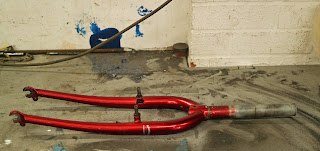Same story with the fixed gear winter/trainer. 10-25 degrees is apparently where the lube’s qualities are best. Having replenished Ursula’s thirsty links, I only needed to wait five minutes before it turned from creamy to glazed. Much cleaner too. Not necessarily ideal for weekend/ sunny days’ bikes but not necessarily a bad choice either-so long as you don’t mind reapplying a light coat each week. Talking of lubes, I’ve played with the Silca Secret Formula Chain Lube long enoughto form firm conclusion Silca Super Secret Chain Coating | cycling-not-racing (sevendaycyclist.com)
Steve's also been impressed by the Blub Chain Lube BLUB Chain Lube | cycling-not-racing (sevendaycyclist.com)Though unplanned, the Continental Cross King has proven a positive move. In common with the Maxxis, it’s relatively quick on tarmac and hardpack surfaces and sufficiently nimble along gravel roads, green lanes, and forest trails. I’m pondering going the Continental route up front too-again, with the puncture-repelling belt.
As for the camera mount, well, that’s going to need some revision. The preset positioning is obscuring the Giant computer and I’ve also noted the camera platform, coupled with the use of resins isn’t adequately supporting the camera’s weight, resulting in shake and therefore blurred footage. I’m pondering whether I can revise this mount, or maybe salvage the Minoura. Perhaps a “permanent” bar bag, rear mudguard upgrade...Aside from consumables and testing, I’m not looking to change Ursula’s spec. The old girl is staying in Monster Cross guise.
The recent blowout allowing, all the tubes have been easily patchable and have returned to the Axiom Ocean City Wave City+Seat Bag AXIOM OCEANWAVE CITY+ SEAT BAG | cycling-not-racing (sevendaycyclist.com), a packet fresh WTB tube has also been parked in the bottle cage caddy. It’s been a bit of a journey, these past 25 years in life and indeed, component changes reflect this. Ursula: The Never-Ending Story | cycling-not-racing (sevendaycyclist.com)
Tag along tug, four seasons hell n’ high water, Ursula has been a friend, a confident and a reliable companion through some extremely turbulent times. While the days are quite chill suggesting winter hasn’t relinquished its grip just yet, there’s a brighter, sometimes drier narrative. It’s light by 630, enticing me to head out earlier and enjoy the peace.
I’ve reached the conclusion that the most important components on a working bike are well sealed, hubs, headsets, bottom brackets, and sturdy paint.
Opinions vary when it comes to colours. Skid mark brown certainly has a wealth of benefits, especially on the theft -repelling front. However, I’m drawn to more neutral livery- dove grey, cream, blues etc. I’ve occasionally toyed with the idea of a bold, vibrant purple next time round but “light” (Ral 7035) grey with a tough clear lacquer coat seems the most likely candidate, come the time the timeless cream starts looking, er, tired… (tyre photo Michael’s garage).
Not to be left out, the fixed now features this rather lovely Ritchey WCS Carbrillo Saddle. Aimed at road and gravel audiences and measuring 260x146mm, it’s slightly shorter and broader than my “bike-fit” ideal but this wider, flatter shape has some other interesting features. First up, there’s the patented “Vector Wing” technology, which I’m told features across all Ritchey saddles.
This means the rails (stainless steel, in this instance) are isolated to help prevent hot spots by dissipating pressure more evenly, away from the sit bones for “all day” comfort. The cover is also noteworthy since it's seamless and attaches to the base without glue, staples, or stitches. As for the padding, it's a light polyurethane foam. As the name and 227g might suggest, there’s also some carbon involved. It features in the shell, which is a nylon/carbon fibre mix.
Shorter nose saddles are designed for riders who want to assume a lower more aggressive stance, although at 260mm, the WSC is much closer to a traditional road saddle (and none the worse for it). Stubbier designs have been compatible with me in the short terms but in practice, I favour something slightly longer. These things aren’t an exact science and as I’m always saying, contact points are the most personal, some might say, divisive points.
Plan is to do three hundred miles on the fixed and then switch to Ursula, to test not only its comfort and performance on and off road, but to see if a more upright positioning, placing greater weight on the saddle has any impact. Then of course, there’s the flat profile. Does this have any impact when re/mounting along more technical, or potentially boggy sections of trail for example. 300 miles on each should give sufficient insight into its longer-term comfort, considerations, and potential limitations.
Do those extra 3mm improve, or detract from comfort, does the sculpted design make any tangible difference? Racing and touring may seem worlds apart but the common link concerns equipment. Saddles being obvious examples, but it goes much wider and includes a change, or tweak to positioning. Never roll up to the start line, or into the wide blue yonder with equipment that’s fresh from the box- get at least a couple of hundred miles with it, while the stakes are low. New bike, groupset, wheels, panniers, shorts, shoes, shifters, the rule applies. I'll close here with my review of the Leatt Jacket MTB Endurance2.0 Leatt Jacket MTB Endurance 2.0 | cycling-not-racing (sevendaycyclist.com)



























